Kentrosaurus, a genus of stegosaurid dinosaur, lived during the Late Jurassic period. Discovered in the early 20th century, this dinosaur is known for its unique body structure. It was a smaller version of the more famous Stegosaurus with a double row of spikes and plates along its back and tail.
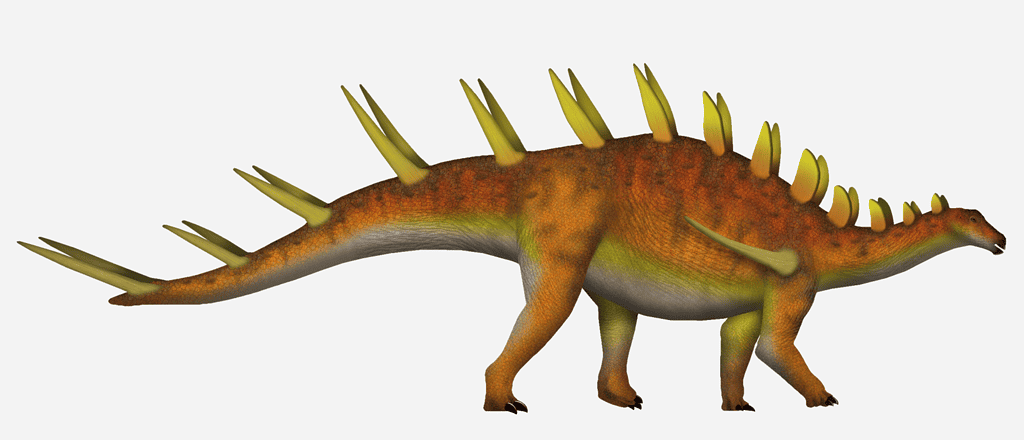
Discovery and Naming
Kentrosaurus‘ story begins during German expeditions to what was then German East Africa, now Tanzania, between 1909 and 1912. These expeditions unearthed hundreds of bones in the Tendaguru Formation, a site rich in Jurassic-era fossils. Edwin Hennig, a German paleontologist, first described the type species, K. aethiopicus, in 1915, formally introducing Kentrosaurus to the world.

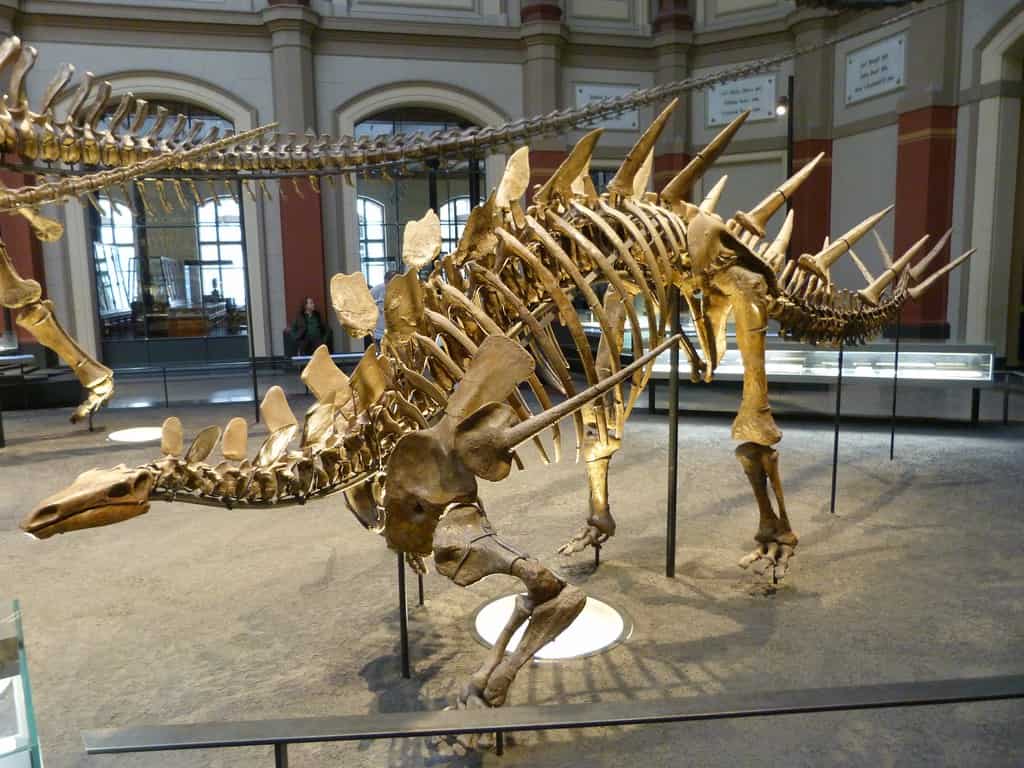
The name Kentrosaurus, derived from the Greek words for “sharp point” or “prickle” and “lizard,” aptly describes the dinosaur’s appearance. However, shortly after its naming, a controversy emerged due to its name’s similarity to Centrosaurus, a Cretaceous ceratopsian. To adhere to the rules of biological nomenclature, which forbid homonymy, Hennig proposed an alternative name, Kentrurosaurus, in 1916. Simultaneously, Franz Nopcsa, a Hungarian paleontologist, suggested Doryphorosaurus. Despite these efforts, the original name Kentrosaurus stuck because the spelling difference was sufficient to distinguish it from Centrosaurus.
Physical Description
Kentrosaurus was a smaller member of the Stegosauridae family that grew approximately 4.5 meters long and weighed around 1,000 kilograms. This quadrupedal dinosaur featured a unique combination of small plates and elongated spikes that adorned its neck, back, and tail. The body structure of Kentrosaurus was robust, with straight hindlimbs that contrasted with the more flexible forelimbs.
Interestingly, Kentrosaurus exhibits potential signs of sexual dimorphism (differences in physical appearance between sexes), particularly in the variation of femur bones. Some bones appear more robust than others, suggesting differences between males and females, either in size or perhaps in mating behavior.

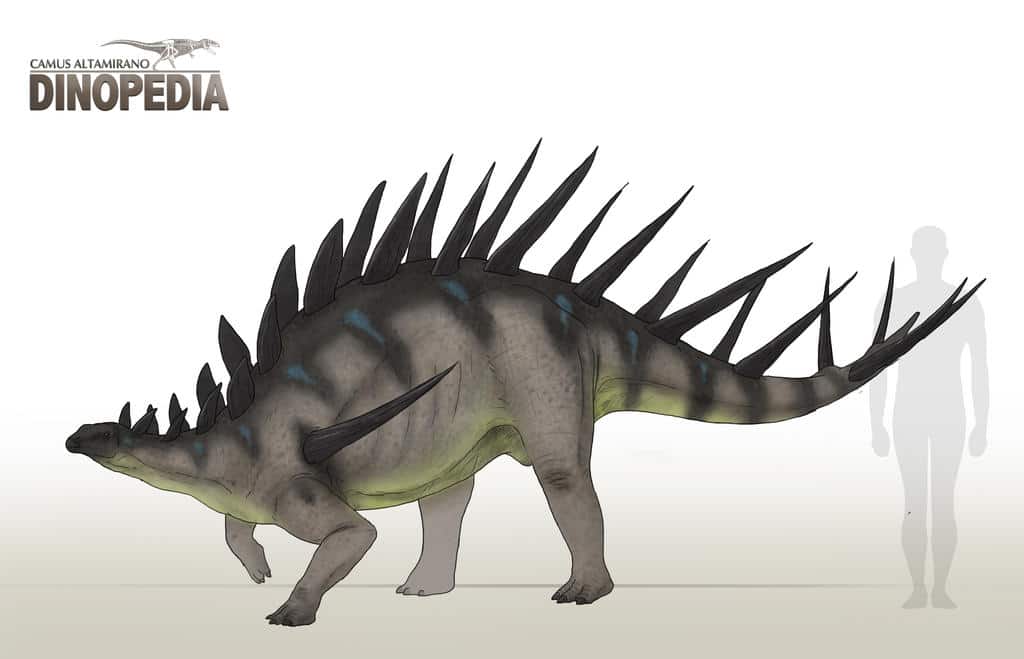
Kentrosaurus’ skull was elongated, featuring a beak-like structure at the front, typical of herbivores. Its dental arrangement and jaw structure suggest a diet primarily composed of low-lying vegetation. However, Kentrosaurus may have exhibited a unique feeding behavior by adopting a tripodal stance. This posture involved the dinosaur rearing up on its straight, sturdy hindlimbs while using its tail for balance. This way, Kentrosaurus could access higher vegetation that would be out of reach for a strictly quadrupedal stance. Such a pose suggests the dinosaur’s hindlimbs and tail were pretty flexible and strong.

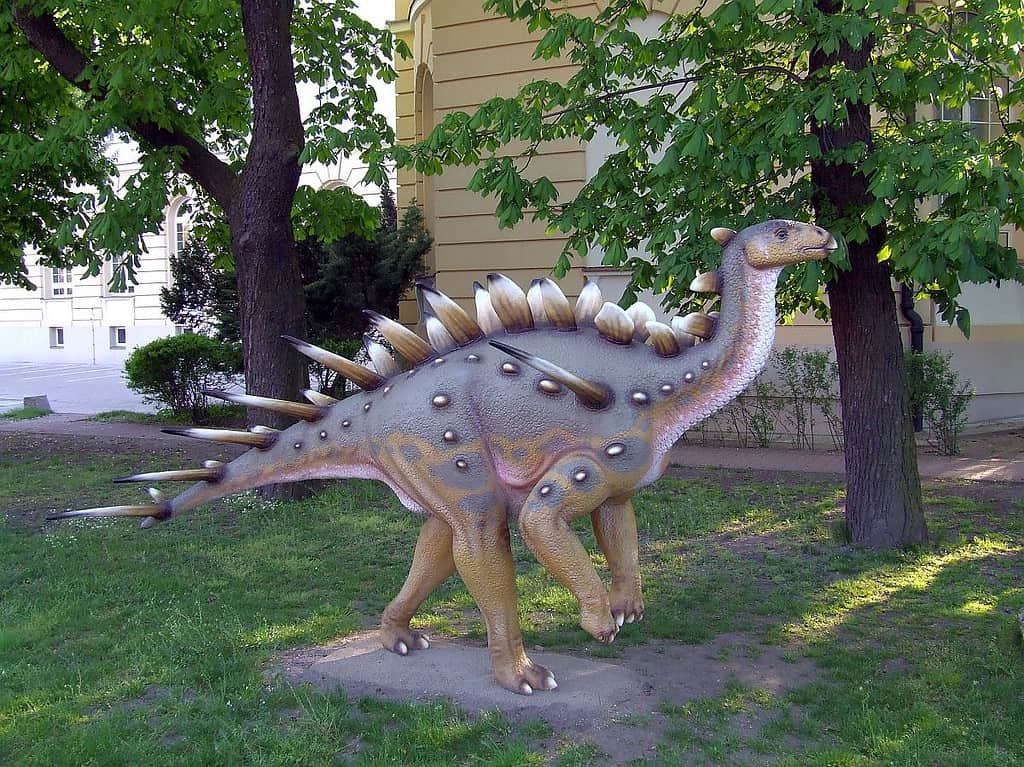
Central to Kentrosaurus’ physical description is its defensive armor. Starting from the neck, a series of small, bony plates ran along the dinosaur’s back, gradually giving way to longer, sharper spikes as they progressed towards the tail. The culmination of this defensive feature was the thagomizer at the end of the tail, which would have been a menace to any predator. A double row of these spikes and plates differentiates Kentrosaurus from the rest of the Stegosaur family. This arrangement would have allowed a higher degree of flexibility and control over its tail, allowing for effective defensive maneuvers.
Habitat and Diet
Kentrosaurus lived in the Late Jurassic period, specifically within the Tendaguru Formation in the modern-day Lindi Region of Tanzania. This region was characterized by lush forests and open plains, providing a rich habitat for a variety of dinosaurs and other prehistoric life forms. The Tendaguru Formation is known for being one of the most prolific African dinosaur fossil sites. The region was home to colossal sauropods like Giraffatitan, Janenschia, and Tornieria, and smaller dryosaurids like Dysalotosaurus. Predatory dinosaurs such as Allosaurus, Ceratosaurus, Elaphrosaurus, Veterupristisaurus, and Ostafrikasaurus also shared the land, threatening herbivores.

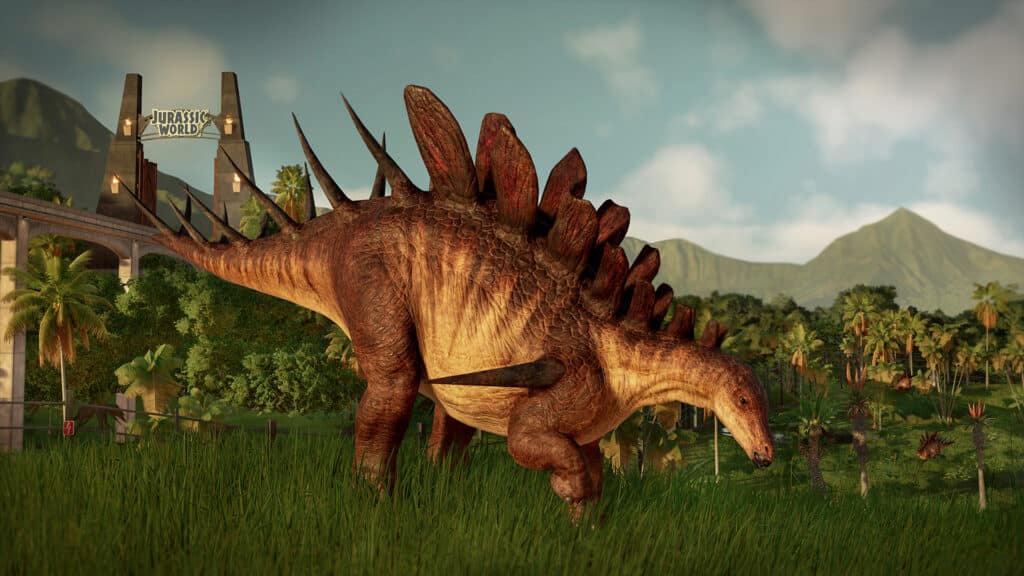
Diet-wise, Kentrosaurus was a herbivore, as indicated by its physical adaptations such as a beak used for clipping vegetation and cheek teeth designed for grinding plant material. The presence of a large gut further suggests a diet that relied heavily on fermenting plant matter to extract nutrients, a common trait among herbivorous dinosaurs. The Late Jurassic Tendaguru plant life likely consisted of ferns, cycads, and conifers.
Behavior and Defense Mechanisms
Kentrosaurus‘ behavior, particularly its defense mechanisms, can be inferred from its physical attributes and environment. Its most notable defensive features were the spikes and plates along its body, culminating in long, sharp spikes at the tail end, known as a thagomizer. These spikes were likely used actively in defense against predators as Kentrosaurus was not built for fast movement. This dinosaur fought, not flew. The ability to swing its tail, armed with these spikes, would have made Kentrosaurus a difficult adversary.
The arrangement of its spikes suggests that Kentrosaurus had a highly flexible tail capable of delivering powerful blows. The spikes on its shoulders and hips could have also deterred attackers from trying to approach from the sides.

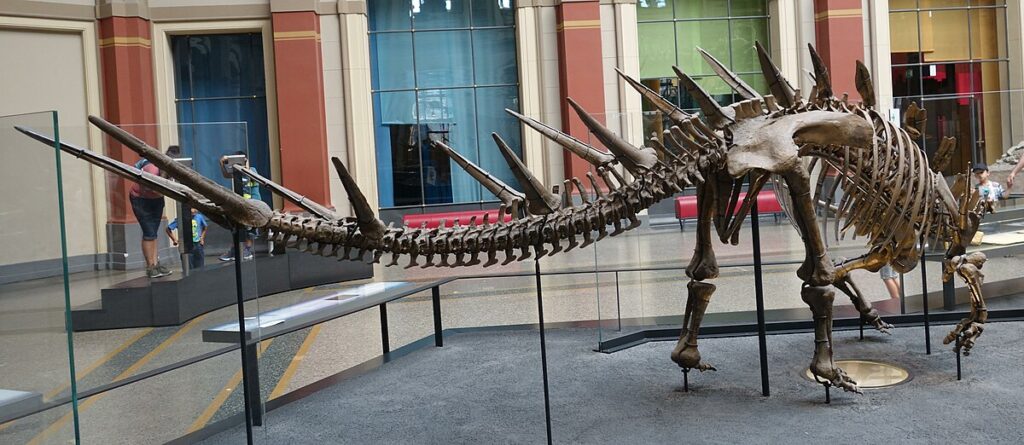
Beyond defense, Kentrosaurus‘ behavior remains speculative. However, the differences in femur bones suggest the possibility of sexual dimorphism, which might imply certain social behaviors during mating seasons. Think of the peacock’s dance to impress peahens. Such physical differences could indicate varying social structure roles or strategies for attracting mates. While direct evidence of social behavior in Kentrosaurus is scarce, the possibility that it lived in groups cannot be ruled out. Living in groups could have provided additional protection against predators and facilitated the breeding and rearing of young.
Classification and Evolutionary Significance
Kentrosaurus is classified within the Stegosauridae family, dinosaurs known for their distinctive back plates and tail spikes. This classification is supported by numerous features of its skeletal structure, which align closely with those of other stegosaurids.
Despite often being thought of as a “primitive” member of this group, recent analyses have placed Kentrosaurus in a more derived position, closely related to the North American Stegosaurus. Its existence in Africa during the Late Jurassic period provides evidence of the widespread distribution of stegosaurids across ancient Pangaea before the continents drifted apart. This wide distribution underscores the ecological success of the Stegosauridae family during the Jurassic period.

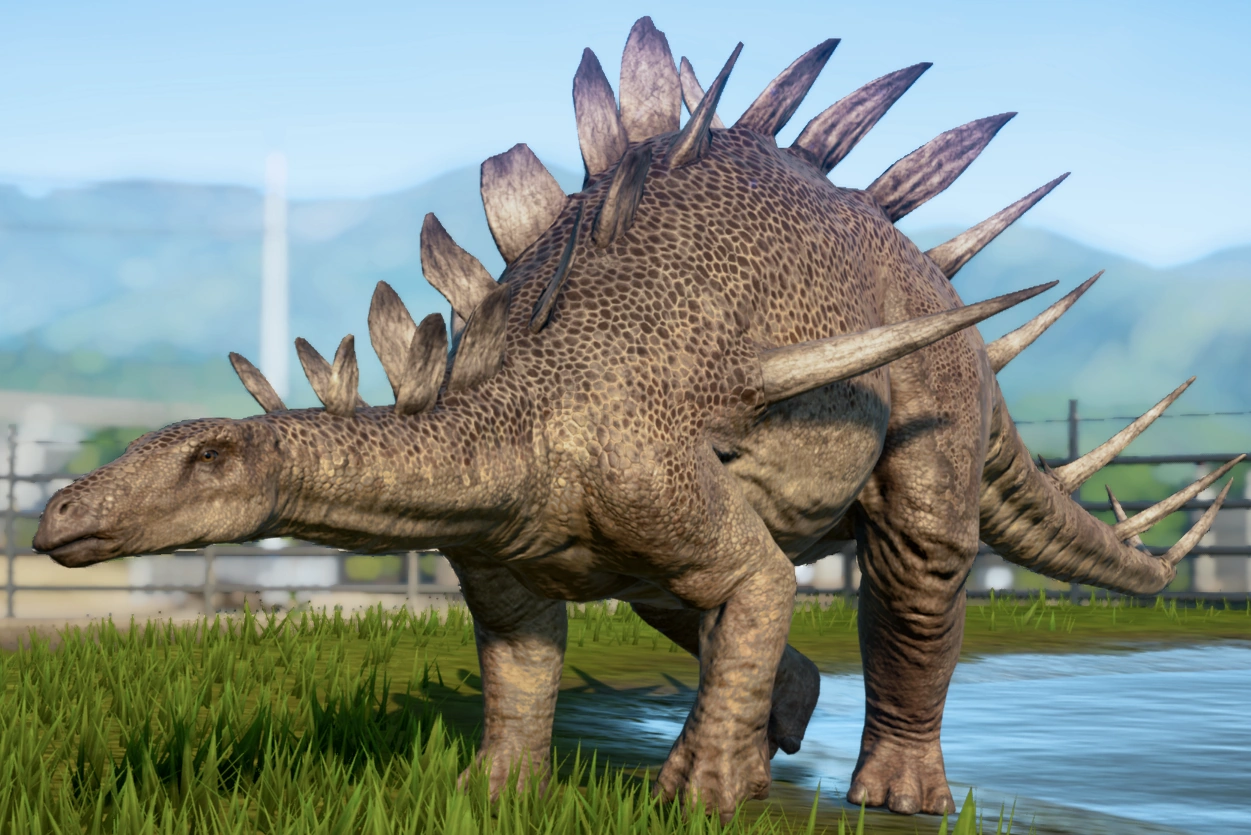
Kentrosaurus in Popular Culture
Kentrosaurus, while not as prominent in mainstream media as its larger cousin, Stegosaurus, has made some appearances in various forms of popular culture.
In the video games “Jurassic Park: Operation Genesis” and “Jurassic World Evolution”, players can create their own dinosaur parks, with Kentrosaurus being one of the species they can include.

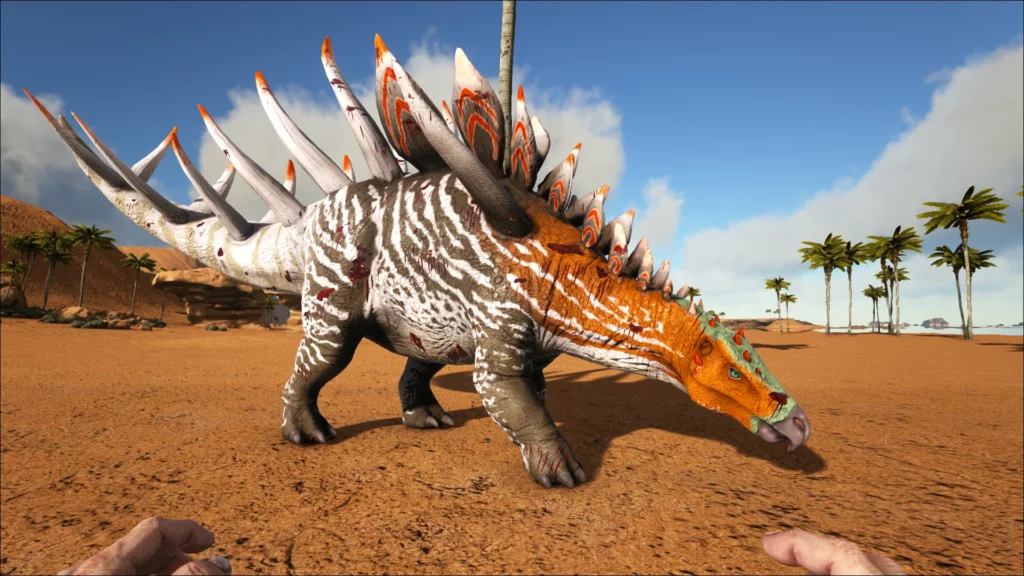
In “ARK: Survival Evolved” players can encounter Kentrosaurus as both a challenge and a potential ally within the game’s prehistoric world. Its portrayal emphasizes the dinosaur’s defensive capabilities and the strategy involved in interacting with such a creature in a survival context.

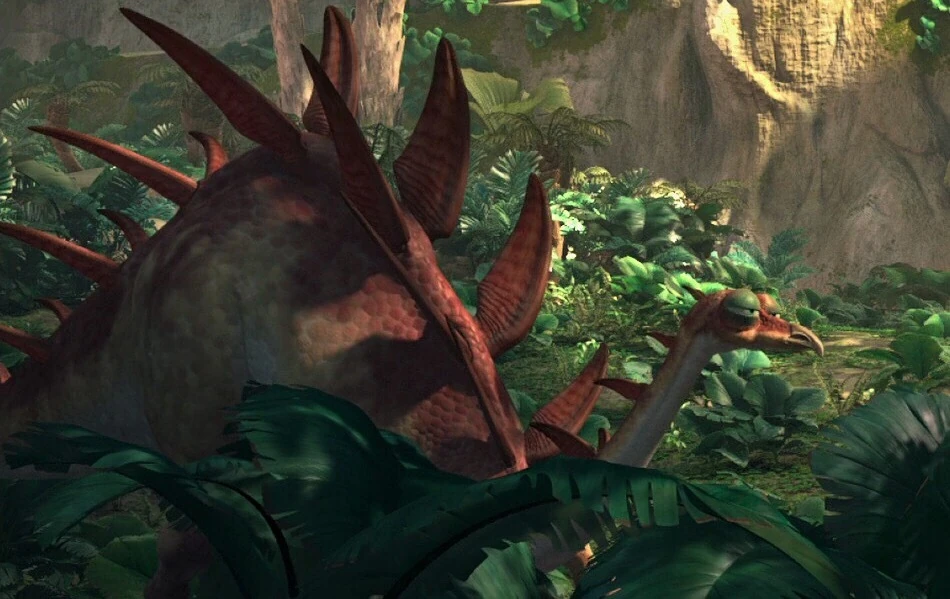
The “Ice Age” franchise features a short Kentrosaurus cameo as the protagonists venture into the underground world where dinosaurs still exist. The animal is humorously portrayed, exaggeratedly thin, and missing the large side spikes.
Thanks for your feedback!
